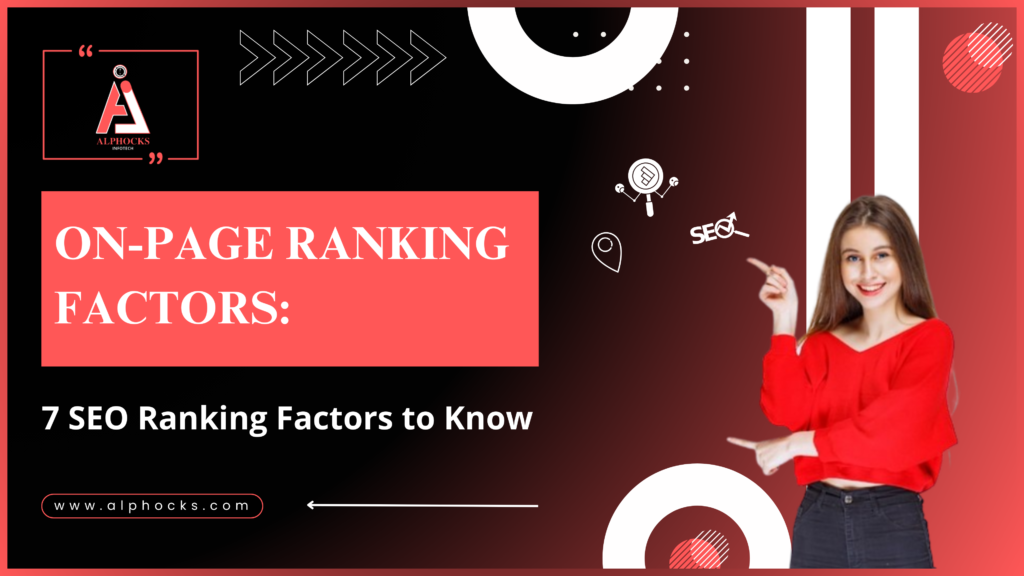In the world of Search Engine Optimization (SEO), on-page ranking factors are a deciding factor in where your website ranks within search results. Since these factors are all under your control, you can improve them on your site or blog post and increase the likelihood of ranking higher. Here are 7 key on-page ranking factors you need to be aware of:
1. Keywords
They are the most basic level of SEO. These are the words and phrases that individuals enter into search engines. Use related keywords with Google Hummingbird; the search algorithm looks at your keywords and the context in which they are used.
- The title tag
- Meta description
- Headers (H1, H2, etc.)
- Within the content (without going overboard with keywords)
Where you fit in keywords, make sure that they can organically sit within the sentences of your content and solve for search intent behind searches.
2. Content Quality
Content is king in SEO. If you write high-quality and relevant content for the user, it has a chance of ranking in the Google search engine. Aim for:
- Clear, concise content
- Extensive coverage with great info on the topic
- Multimedia – images, videos, and infographics to increase engagement
Since Google likes pages that provide satisfactory answers to user questions, reframe the content into an answer format for each of these.
3. Page Loading Speed
Page load time is an essential component of a good user experience and SEO. A slow page speed increases bounce rates and can affect your search rankings. To improve loading speed:
- Use browser caching
- Minimize HTTP requests
- Optimize images and videos
- Choose a reputable hosting company
You can identify where you need improvements with tools like Google PageSpeed Insights.
4. Mobile Friendliness

With more searches taking place on mobile devices rather than old desktops, Google values websites that are friendly for the smartphone. All these URLs must be formatted following the correct way to ensure that they are friendly in search engines as:
- They provide a satisfactory experience for the user on different devices free of Flash and pop-ups installations, which consume precious time mobile uses with poor navigation.
- The design should respond to various screen sizes, and you can test using Google’s Mobile-Friendly Test Site.
- Google also recommends avoiding simple errors like 404s but it is clear all these considerations might drain your batteries work-portable forefront ticket!
5. Internal Linking
Internal links connect your content and guide search engines in understanding the hierarchy of structure on the website. They divide page authority and allow users to browse your site. Key Points to Remember in Internal Linking:
- Use descriptive anchor text that features the query subject
- Keep internal linking strategies natural and user-focused
- Make sure your links are relevant, informative information for what kind of material would be helpful or beneficial
Add internal links will assist with crawlability while giving users pathways through more content.
6. Meta Tags
Meta tags tell search engines what your web page is about. Meta tags, like metadata for a webpage, are those short pieces of text that explain what your page is in the eyes of Google. The two most important meta tags from an SEO perspective:
- The Title Tag: This is essentially the clickable headline you see on search engine results pages. It needs to be short, include keywords users are likely searching for, and most importantly, makes the user want to click on it!
- Meta Description: The meta description gives readers an idea of what the page is about. It should be engaging, with the use of appropriate keywords screaming to your visitors making them want to check out more on your site.
Crafting good meta tags can increase CTR from search engine results pages (SERPs).
7. URL Structure
Like anything else in this field, a readable URL structure makes it easier for the user to identify content as well. Best practices:
- Utilizing hyphens to delineate terms
- Keeping URLs concise and comprehensible
- Having informative search phrases in the URL
- If possible, avoid complex SEO parameters.
A well-structured URL makes it easier for users to understand what the page is about and can improve click-through rates.
Lastly, A good and clean URL helps visitors know what your page is concerning thus it can help with CRT (click-through rates). At the end of the day, optimizing these seven factors can vastly improve your website SEO performance so it is important to take note. Improving site speed, mobile-friendliness, and child themes are all things you can do to make your website rank higher in search engine results so that more people will (hopefully) see your content. Keep in mind that SEO is not a one-time activity and you need to make sure that these parameters are updated for better search ranking.



